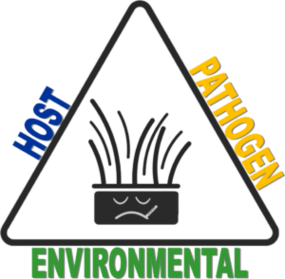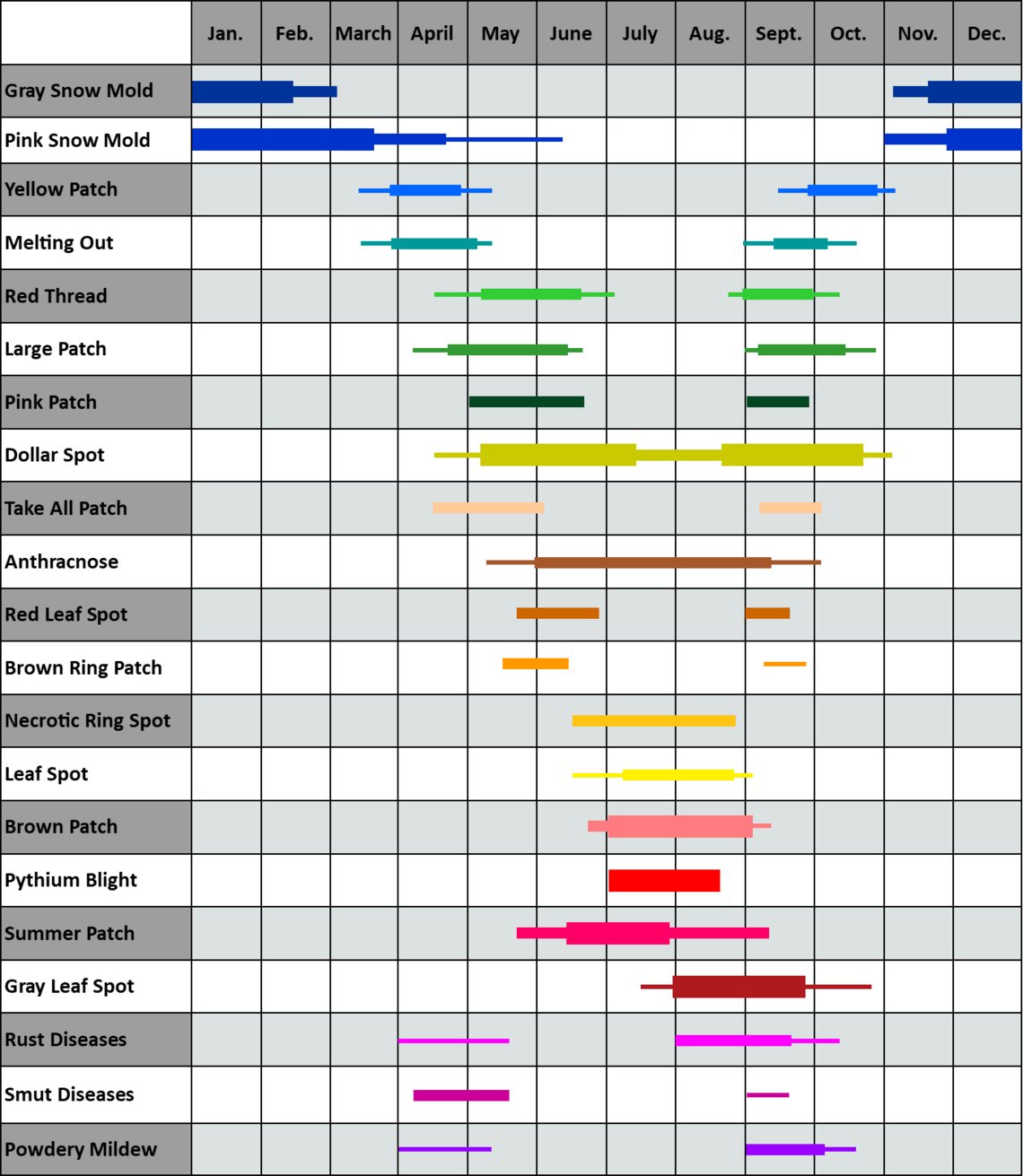Any lawn is host to millions of microorganisms essential to its health and growth, many of which are different varieties of lawn fungus and are highly beneficial. Some grass fungus types even protect your lawn from disease by attacking pathogens, while others out-compete them for resources. However, some lawn fungus cause lawn diseases that mar the lawn's beauty and threaten its survival. Let's dig in and explore disease-causing types of fungus on grass and the best ways to prevent or get rid of them.
Understanding Lawn Diseases
Various types of grass fungus cause lawn diseases. Many develop in warm, wet conditions, while others actually build up under snow cover. While lawn fungus can survive under a number of conditions, certain needs must be met for it to reproduce and flourish.
The Disease Triangle Explained
All lawn diseases and pathogenic lawn fungus infections require three components to become active. These components are:

HOST – The host plant must be susceptible to the disease.
PATHOGEN – The lawn disease pathogen must be present.
ENVIRONMENTAL – Conditions must be favorable for a successful infection.
Together, these three essential components form what is called the disease triangle. If any one component (or side of the triangle) is missing or eliminated, then the disease can't manifest and damage your lawn. The concept of the disease triangle is critical to combatting lawn fungus and disease.
Eliminating the fungus spores is functionally impossible, but you can minimize the likelihood of disease by choosing more disease-resistant grass seeds for your lawn. Your lawn care practices can also significantly change the environmental conditions, making them less favorable and taking that leg away from the triangle.
Here are a few ways you can protect your grass from lawn fungus:
- Choose a disease-resistant grass seed like Tall Fescue when over-seeding your lawn.
- Mow tall and mow often, making sure to follow the one-third rule.
- Water in the morning so the grass can fully dry between waterings.
- Make sure to fertilize your lawn properly.
Common Spring Lawn Diseases
Many types of pathogenic grass fungus cause visible damage to the lawn, including yellow or brown patches in various shapes and sizes. For instance, brown patch fungus causes roughly circular-shaped patches of brown grass of multiple sizes. Greater areas of damage are caused by larger patches, while dollar spot fungus causes many yellow to brown spots about the size of a silver dollar.
Different types of pathogenic lawn fungus emerge and proliferate at different temperatures. Our graphic demonstrates the general timing and overlap of the 21 most common grass fungus infections as they occur in Indianapolis. The timing of fungal infections in your climate may appear earlier in warmer climates and later in the year when it's cooler.

Prevention Strategies
Preventing a grass fungus disease is easier (and far less costly) than trying to cure one. Choosing a disease-resistant grass seed and proper lawn maintenance practices are crucial.
Selecting the Right Grass Seed
No grass seed is resistant to all lawn fungus diseases or performs well in all climates. For example, some types of Tall Fescue are resistant to brown patch fungus but susceptible to pythium blight. When choosing grass seed, it is essential to select a type suited to your specific region's climate and known to perform well against the most common lawn diseases in your area.
Proper Lawn Maintenance
Proper lawn maintenance is critical to preventing the development of all types of pathogenic grass fungus. The following are the best practices for preventing lawn fungus problems:
- Water early in the day so the grass dries well.
- Sharpen your mower blades to keep cuts clean. Ragged, torn grass gives fungal spores too many openings.
- Mow high, at least three inches tall, and follow the one-third rule.
- Do a soil test and fertilize your lawn according to its needs. Avoid under- or over-fertilizing.
- Dethatch your lawn once a year, in the fall. This removes moisture-retaining thatch that can harbor fungal pathogens and spores.
- Aerate your soil, improving drainage and promoting healthier root development.
- Control pests that feed on grass and roots, weakening the lawn's health.
- Eliminate broadleaf weeds that compete with the lawn for nutrients and resources.
When to Seek Professional Help
The lawn care best practices described above are your best chance of preventing lawn fungus. However, if your lawn shows severe signs of grass fungus or a significant portion of it is affected, perhaps 20% to 30%, it's time to call in professional help. Lawn Pride® provides fungicide treatments that treat the fungal infections that damage our clients'lawns.
Treatment Options To Fight Lawn Fungus
If your grass is infected with a lawn fungus, you have a few treatment options. If you know the grass fungus you're battling, an over-the-counter fungicide targeting that specific pathogen is an excellent choice. Follow the package instructions carefully for application. Several natural treatments are available that can be quite effective, particularly if you catch the infection early and start treatments promptly.
Natural Lawn Fungus Remedies
The following natural lawn fungus treatments are gentle on the environment (and your wallet) but tough on the early stages of fungal infections. Do not apply these treatments in the heat of midday. Instead, treat grass fungus in the morning or late afternoon while there is still sufficient heat to dry the treatment before nightfall.
- Neem Oil: Mix three tablespoons of neem oil with one gallon of water and spray the lawn fungus every few days.
- Baking Soda: Mix two teaspoons of baking soda into a gallon of water and apply to affected grass every three days.
- White Vinegar: Mix a 1:1 vinegar water solution. Apply to fungal-infected grass once.
- Baking Soda, Vegetable Oil, and Liquid Soap: Mix two teaspoons each of baking soda, any vegetable oil, and liquid soap that has no detergent into a gallon of water. Apply to affected grass once.
Each of these natural grass fungus treatments could damage your lawn, so choose one and apply it just to the affected areas. Watch closely for signs of damage, and call for professional help if the fungus persists.
Chemical Treatments
Chemical lawn fungus treatments can also damage healthy grass, so choose wisely. If you know the type of grass fungus you have, look for a treatment that specifically targets that type. Follow the directions carefully, and don't apply too much. If you notice the treatment causes damage or the fungal infection persists, call your local Lawn Pride for assistance.
A Healthy Lawn is the Best Defense to Lawn Fungus
Proper lawn maintenance and healthy, robust grass is the best defense against lawn fungus diseases. Follow our guidelines above to prevent infection. If you're ready to offload your lawn care or just want a helping hand, Lawn Pride can safeguard your grass's health or reclaim it from lawn disease.
We know you'll be pleased with our lawn care services because the Neighborly Done Right Promiseâ„¢. Your satisfaction with your lawn and our service is our highest priority. Contact us today and get a free estimate. Because we take pride in your lawn.
